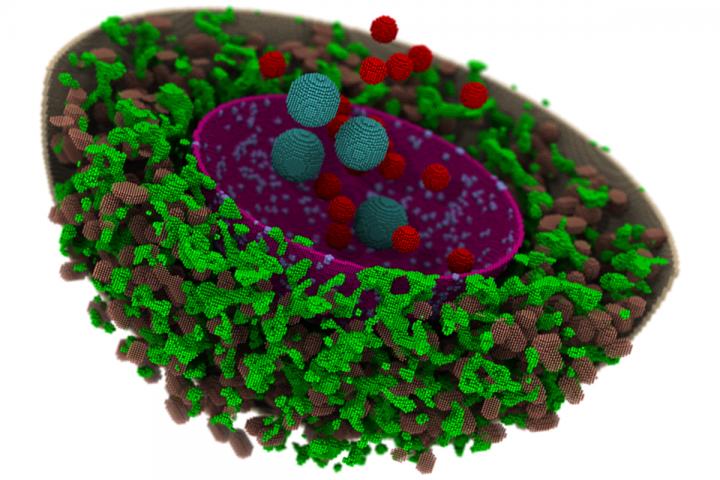
Credit: Graphic courtesy Zhaleh Ghaemi
CHAMPAIGN, Ill. — Researchers have developed the first computational model of a human cell and simulated its behavior for 15 minutes – the longest time achieved for a biological system of this complexity. In a new study, simulations reveal the effects of spatial organization within cells on some of the genetic processes that control the regulation and development of human traits and some human diseases.
The study, which produced a new computational platform that is available to any researcher, is published in the journal PLOS Computational Biology.
“This is the first program that allows researchers to set up a virtual human cell and change chemical reactions and geometries to observe cellular processes in real time,” said Zhaleh Ghaemi, a research scientist at the University of Illinois at Urbana-Champaign and lead author of the study.
Working off the notion the insides of cells are packed with various organelles and molecules, the group, led by U. of I. chemistry professor Zaida Luthey-Schulten, focuses on how the movement of individual molecules around the many obstacles affects the chemical reactions inside cells.
To test the new model, the team performed simulations of a process called RNA splicing, which is one of the most complex cellular processes and a hallmark of human cellular biology, the researchers said.
“RNA splicing changes the messenger RNA molecules that carry information needed from DNA to form proteins,” Ghaemi said. “The process uses a complex cellular machine – called a spliceosome – that requires the trafficking of precursor and mature components around the highly compartmentalized parts of a cell. This makes RNA splicing ideal for studying how spatial arrangement affects the various chemical reactions that take place in cells.”
The new simulations revealed a rationale for why precursors of the spliceosome move between the nucleus and cytoplasm compartments, the researchers said.
“Even though this movement seems somewhat inefficient and counterintuitive at first glance, our simulations indicate that they are essential to the proper RNA splicing, and therefore protein synthesis,” said Martin Gruebele, a chemistry professor and study co-author. “When protein synthesis goes awry, it can lead to disease, including cancer,”
The researchers designed the computational platform to model a variety of cellular processes while being fully customizable by the researcher using it. “For example, we could use this model to observe what types of proteins will form if the RNA-splicing process were to remove only two parts of a DNA sequence instead of three,” Luthey-Schulten said. “This could provide insights into how different proteins form and influence the development of cancer cells.”
Although the most comprehensive human cell model to date, the computational model still has ample room for advancement and customization to study other cellular processes, the researchers said.
“This simulation allowed us to observe the RNA splicing for 15 minutes,” Gruebele said. “Ultimately, we would like to be able to run the program for much longer and include all of the proteins that are required for gene replication, allowing us to observe cell division in real-time. The possibilities for our group – and others because the program is open access – are endless.”
###
Luthy-Schulten also is affiliated with the physics department, the Beckman Institute for Advanced Science and Technology and the Carl R. Woese Institute for Genomic Biology at Illinois.
Gruebele heads the chemistry department and also is affiliated with physics, the Center for Advanced Study, the Beckman Institute and the Carle Illinois College of Medicine at Illinois.
Editor’s notes:
To reach Zhaleh Ghaemi, call 217-721-8644; email [email protected].
To reach Zaida Luthey-Schulten, call 217-333-3518; email [email protected].
To reach Martin Gruebele, call 217-333-1634; email [email protected].
The paper “An in-silico human cell model reveals the influence of spatial organization on RNA splicing” is available online and from the U. of I. News Bureau.
DOI: 10.1371/journal.pcbi.1007717
Media Contact
Lois Yoksoulian
[email protected]
217-244-2788
Original Source
https:/
Related Journal Article
http://dx.




